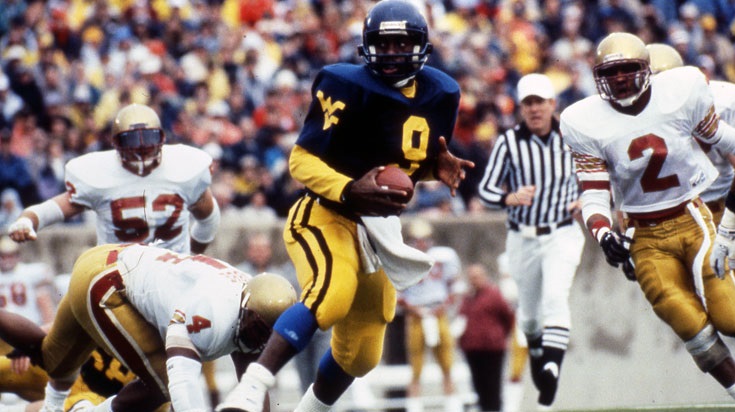The hardest thing to do back in the 1970s and 1980s at West Virginia University football games – almost as hard as beating Penn State – was getting a great color action photo.
Number one, the equipment back then was much more primitive than it is today and the really good stuff cost a small fortune; number two, photo processing was laborious and time consuming; number three, the lighting in most stadiums was typically awful and, finally, Photoshop was then only just a thought in the back of Thomas Knoll’s mind when he was a doctorate student at the University of Michigan.
No place proved more challenging to get good photographs than new Mountaineer Field, where the stadium’s nine-story-high press box created a massive shadow over the field on sunny afternoons. The really good photographers who shot games back then always prayed for overcast days.
“It was really difficult to shoot whenever the action went toward the hospital,” recalled longtime local photographer Dale Sparks, who owns and operates the Dale Sparks Collection and has been shooting Mountaineer athletics since the mid-1980s. “There was such heavy backlighting that you had to overexpose everything just to lighten up the faces.”
During night games, the two light poles on the far side of the stadium barely provided enough illumination for telecasts, let alone getting a decent color action picture.
In fact, the lighting was so bad that Kevin Keys, West Virginia’s sports publications director who was in charge of hiring WVU game photographers back then, deployed very few of them for night games because he knew most of what they shot would not be usable.
Unfortunately for guys like me who love bringing Mountaineer football’s rich history to life, some of West Virginia’s biggest games in the 1980s and 1990s occurred at night, meaning there were very few good photographs available to use.
West Virginia’s great 17-14 upset win over Penn State under the lights at Mountaineer Field in 1984?
Very little photography.
The Mountaineers’ comeback victory over fourth-ranked Boston College in ’84 that ended after dusk, or the West Virginia-Miami game in 1993 or the 1998 season opener against Ohio State that kicked off in prime time?
Same deal.
The absolute worst-case scenario for any good photographer during the pre-digital/pre-Photoshop days was being asked to take an action photo of a player wearing a dark helmet and a dark jersey at night at Mountaineer Field.
“Almost an impossibility,” recalled longtime West Virginia University photographer Greg Ellis.
Even today, there are only so many things that you can do to an image in Photoshop to improve it.
“Whatever you do, there is always some compromise,” noted Ellis.
Photography is a tricky deal, especially for amateurs. About 98 percent of us know very little about exposure, backlighting, color balancing and the like, and even less than that know what it takes to get a good picture.
But all of us know a terrific photograph when we see one, and there is nothing that tells a story quite like a great color photo of a fingertip catch for a touchdown, the mud flying through the air on a rainy afternoon, or the blood oozing down the face of a wounded player who is being helped to the sideline.
Years ago, whenever you got a picture like that it was used over and over and over because those photos were so hard to get. Even the good photographers weren’t totally certain what they had until they began processing their film.
“You had an idea, but you were never 100 percent sure,” said Sparks.
“Now you can see what you get right away,” added Bill Amatucci, a Latrobe, Pa., resident who began shooting for the Pittsburgh Steelers in 1975 and has shot Mountaineer home football games since 1988. “You can see if you’re on with your exposure and you can see if you were sharp. Shooting back then, the first thing that was in your mind was ‘was is it sharp?’ And then, ‘was it exposed right?’”
Dan Friend, recently retired WVU photographer who today operates a gallery in Morgantown, said the experienced photographers used to tease the students who would attempt to develop their out-of-focus photos.
“We used to tell them to go back into the darkroom and get the ‘focus developer,’” he chuckled.
That would be similar to finding a box of curveballs, some left-handed footballs or a bucket of steam – it doesn’t exist.
Twenty five or 30 years ago, Friend said it was very difficult for a photographer to shoot the ball leaving the hand of a quarterback and follow it all the way to the receiver’s hands, in focus. The middle-of-the-line cameras that most photographers could afford back then could only shoot 2/3 frames per second and there was no auto focus function.
“Auto focus changed the world for us photographers,” said Friend. “You still have problems with it and you’ve got to know what you’re doing, but I guarantee you it’s much better than the old manual way of shooting. I don’t hear anyone out there saying, ‘I think I’ll shoot manual.’”
Perhaps the most important aspect of taking great pictures is simply having access, says Ellis.
“The lenses are important, but it’s your ability to get close to your subject that’s most important,” said Ellis, who shot for United Press International before coming to WVU three decades ago. “When I was shooting for UPI, the thing I thought was important was getting the face and the ball. That was usually what an editor was looking for.
“The thing that always tells the story – like using the proper words in writing – is the thing that you need in the picture: the jubilation, the blood and the sweat of the game.”
Amatucci developed a reputation for getting great face shots. It began soon after Pittsburgh Steelers publicity director Joe Gordon hired him to shoot Steelers games at Three Rivers Stadium in 1975.
“Even when I was a kid and I was looking at football pictures, I was always looking for the picture that showed the player in a graceful position running with the ball – nothing awkward – sort of like the bubble gum picture card,” said Amatucci. “Joe liked headshots and I sort of developed a knack for shooting headshots through the years.”
Amatucci said when he was shooting wide receivers he learned to position himself behind the offensive line to make sure that he was in the right spot to see their faces whenever they made a catch.
Speaking of positioning, every good photographer will say that it is extremely important to have knowledge of the team you are shooting.
Sparks developed his sports knowledge through the years with West Virginia, first by covering Don Nehlen and then Rich Rodriguez, Bill Stewart and now Dana Holgorsen. He frequently stations himself on the hash in the end zone so he can get a full view of the field, and he also always has a couple of different cameras slung over his neck, switching to the appropriate one depending upon how close or how far away the action is from him.

The sequence of photos Dale Sparks got during Major Harris’ memorable touchdown run against Penn State in 1988, ending with this famous color shot when he crossed the goal line.
All-Pro Photography/Dale Sparks photo
During Major Harris’ famous touchdown run against Penn State in 1988, Sparks was able to switch cameras right in the middle of the play to get black and white and color shots – a feat that is still talked about around here by the photographers who cover the Mountaineers.
Sparks began shooting in black and white with a longer lense, but as he saw Harris breaking into the open he switched to his color camera (with a shorter lense) to finish the sequence.
“It takes a really good photographer to be able do that,” admitted Friend.
In those days, Sparks said he always had to pay attention to what he was doing, either by loading film when there was a stoppage in play or by taking a few extra shots to make sure that he had the numbers of all the subjects that he needed to identify for the cutline, or, to always remember to shoot the scoreboard to mark the key plays in the game.
“You have to know what you’re doing,” said Sparks. “I have never seen a touchdown from the 50 yard line.”
Today, sports photography has come a long, long way, thanks to the many advances made in digital photography. That’s why you now see so many people standing along the sidelines during games taking photos.
Even the middle-of-the-road cameras today can shoot 10 frames per second, compared to just a fraction of that 25 years ago. The auto focus function keeps the inexperienced photographers from looking for the “focus developer,” and the storage drives on cameras now enable photographers to shoot 10-15 times more photos than they used to, meaning the greater likelihood of getting the key play or the great shot that everyone is after.
Still, the lighting is never perfect and the subjects don’t stand still so there will always be a big difference between what you see from amateur and professional photographers – even to the 98 percent of us out there who have no clue what it takes to shoot a great photograph.






























